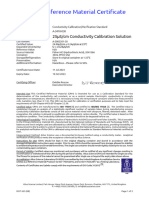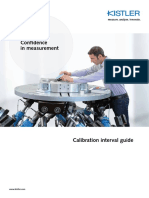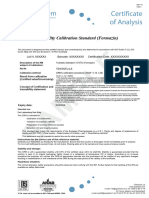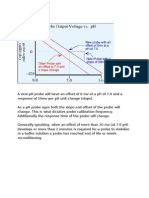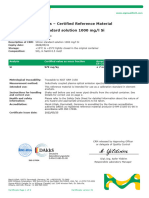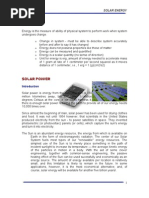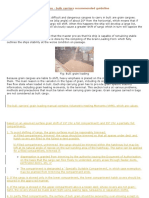Mark 2 Moisture Analyzer Validation Procedure
Mark 2 Moisture Analyzer Validation Procedure
Uploaded by
claus mataCopyright:
Available Formats
Mark 2 Moisture Analyzer Validation Procedure
Mark 2 Moisture Analyzer Validation Procedure
Uploaded by
claus mataOriginal Title
Copyright
Available Formats
Share this document
Did you find this document useful?
Is this content inappropriate?
Copyright:
Available Formats
Mark 2 Moisture Analyzer Validation Procedure
Mark 2 Moisture Analyzer Validation Procedure
Uploaded by
claus mataCopyright:
Available Formats
Mark 2 Moisture Analyzer Validation Procedure
Controlled Document
Doc 041 Rev I / 4-Nov-99 OMNIMARK INSTRUMENT
CORPORATION
Page 1 of 10
1.0 INTRODUCTION
The Mark 2 moisture analyzer system is comprised of a top loading balance, an electronic
controller, quartz infrared heating system, an internal thermal printer, and a supporting
base and cover. This document details the validation test procedures used to verify
performance of the Mark 2 family of moisture analyzers.
Follow the procedures below and record the results on the Mark 2 Validation Checklist
located on page 10 of this document.
2.0 CLEANING OF MARK 2
Procedure:
1) Unplug the unit.
2) Allow the unit to cool for at least thirty (30) minutes.
3) Check that the unit is still unplugged.
4) Use a mild detergent and a soft rag to clean the external surfaces of the unit.
CAUTION: DO NOT IMMERSE unit in water or any other cleaning
solution.
5) Carefully remove the pan support and pan shield to thoroughly clean them.
6) Keep all warning labels clean.
7) Periodically remove the perforated plate by unscrewing the two screws in order
to clean the chamber below. Use extreme care in removing the accumulated
residue with a clean, damp cloth.
8) Replace screws.
9) Keep the mechanical part of the printer free from dirt and dust. Periodically lift
up the printer cover to clean the printer mechanism with a soft brush.
3.0 TOOLS REQUIRED
All tools, fixtures, and other test or assembly devices described in this procedure must be
properly maintained and calibrated, where appropriate. Each device requiring calibration
should have a valid calibration sticker attached to it.
Tools:
Test weight set (2, 5, 20, 20, 50 gram)
External temperature sensor (Tool#T0880)
Digital multi-meter (Tool#T0244)
Standard sample pans (Part#0-2005)
Pan height adjustment tool (Tool#T0252 Rev A)
Mark 2 Moisture Analyzer Validation Procedure
Controlled Document
Doc 041 Rev I / 4-Nov-99 OMNIMARK INSTRUMENT
CORPORATION
Page 2 of 10
4.0 BALANCE FUNCTIONAL TESTS
Note: The unit should be powered up for a minimum of thirty (30) minutes prior
to starting these tests with the following settings.
1) Recall the program "Factory Default" if previously stored. If the settings have
not been stored previously perform the following key presses from the
STANDBY menu to set up the test conditions for the balance functional tests:
Key Description
2 SETUP - Access Setup Menu 1
2 DEVELOP - Access Develop Menu
1 UNITS: MOISTURE - Set unit to moisture %
2 TEMP 1: 105
C - Set Temp 1 to 105
C
6 SLOPE - Change slope settings
2 WINDOW: 1.0 Min. - Set slope window to 1.0 min.
3 %IW: 0.050% - Set slope value to .050%
4 ENDPT: ACTUAL - Set to ACTUAL slope mode
e - Accept current settings
7 STANDBY: 80
C - Set standby to 80
C
9 IDL WT: 5.0 - Set ideal weight to 5 grams
e - Accept current settings
1 SAVE PROGRAM - Save current settings
Enter unused program number - Select an unused program number
Enter "Factory Default" name - Enter program name
These settings should be saved for future reference under the name of "Factory
Default" using any available program number. This program can then be recalled
by name rather than re-programming the settings.
A. Pan Height Check/Adjustment
This section describes the steps necessary to check the balance for the proper
sample pan height. This section is applicable to NR series Mark 2 moisture
analyzers.
Procedure:
1) Remove the pan support and breeze shield.
2) Remove the perforated grill.
3) With the Mark 2 powered ON, place the pan height tool (T0252)
on/over the pan stem. The top of the tube should be level with the top
of the machined groove on the tool + .020 inches. If the top of the tool
is not within this tolerance, an adjustment is necessary. If the top of the
tube is lower than the bottom of the tool the balance is bent and needs
to be returned to Omnimark for service.
Mark 2 Moisture Analyzer Validation Procedure
Controlled Document
Doc 041 Rev I / 4-Nov-99 OMNIMARK INSTRUMENT
CORPORATION
Page 3 of 10
A. Pan Height Check/Adjustment cont.
4) To adjust the pan height, remove the entire cover of the instrument by
removing the hex screw located near the front/center of the unit in the
balance opening. Once the cover has been removed, locate the
adjustment screw at rear of the rectangular balance arm cover. Using a
screwdriver of the correct size, turn the screw 1/16-1/8 turn clockwise
to raise. DO NOT EXERT DOWNWARD PRESSURE ON THE
ADJUSTMENT SCREW. BALANCE WILL BE DAMAGED. Turn
screw until the pan stem is level with the machined groove on the tool.
5) Reinstall instrument cover and grill.
B. Calibration
This test verifies that the "Automatic Calibration" software feature functions
properly. Since the customer should recalibrate the instrument after installation
using his or her own test weights, this test is not meant, as an indication of the
absolute accuracy the customer will experience. From the SETUP 1 menu, select
"4 Calibrate. Place a 50 gram weight on to the pan support and then close the
hood. The CALIBRATION DONE message should appear and then the SETUP 1
menu will be displayed. Open the hood and remove the weight. Record
completion.
C. Linearity
A balance is linear when the displayed weight is equal (within the tolerance
specified) to the actual weight, for weights between minimum and maximum
capacity. To determine if the unit is linear, the same test mass is weighed at two
pre-loads.
Procedure:
1) From the STANDBY screen zero the balance by pressing the REZERO
key.
2) Place a 20 gram test weight in the center of the standard pan and
record the reading.
3) Remove this weight, and then place a second 20 gram weight in the
center of the standard pan. Zero the balance.
4) With the weight from step 3) still on the pan, place the same test
weight used in step 4) above in the center of the standard pan. Record
the reading.
Mark 2 Moisture Analyzer Validation Procedure
Controlled Document
Doc 041 Rev I / 4-Nov-99 OMNIMARK INSTRUMENT
CORPORATION
Page 4 of 10
C. Linearity cont.
Acceptance - Linearity:
The unit is acceptable if the difference between the value obtained in step 4)
and the value obtained in step 2) is less than or equal to the tolerance below:
Mark 2 HP only + 0.0020 grams
Mark 2 + 0.003 grams
D. Repeatability
With the heater hood closed, ZERO the balance and do three (3) successive
weighing with a 50 gram test weight in the center of the standard pan. Record the
readings. The balance is acceptable if the difference between the minimum and
maximum value of these tests is less than or equal to the tolerance of:
Mark 2 HP only + 0.0010 grams
Mark 2 + 0.002 grams
The balance returns to zero using the same tolerances after removing the weight.
E. Stability
The test in this section should be done after a total recommended warm up period
of two (2) hours at a standby temperature of 100
C with the hood closed.
In this test, the stability (drift) of the unit is checked at temperature. From the
default, recall the program "Stability" if previously stored. If the setting has not
been stored previously perform the following key presses from the STANDBY
menu to set up the test conditions for the balance stability tests:
Key Description
2 SETUP - Access Setup Menu 1
2 DEVELOP - Access Develop Menu
1 UNITS: WEIGHT - Set units to WEIGHT
2 TEMP 1: 130
C - Set Temp 1 to 130
C
3 TIME 1: 10.0 min. - Set Time 1 to 10 minutes
6 SLOPE - Change slope settings
1 TURN SLOPE OFF - Turn slope mode OFF
e - Accept current settings
7 STANDBY: 100
C - Set standby to 100
C
9 IDL WT: 5.0 - Set Ideal Wt. to 5 grams
e - Accept current settings
1 SAVE PROGRAM - Save current settings
Enter unused program number - Select an unused program number
Enter "Stability" name - Enter "Stability" program name
Mark 2 Moisture Analyzer Validation Procedure
Controlled Document
Doc 041 Rev I / 4-Nov-99 OMNIMARK INSTRUMENT
CORPORATION
Page 5 of 10
E. Stability cont.
These settings should be saved for future reference under the name of "Stability"
using any available program number. This program can then be recalled by name
rather than re-programming the settings.
Press the START/STOP key to begin the test. When prompted, place a five (5)
gram weight on the standard pan. Lower the hood, the test will begin automatically
after stabilizing. The heating elements will bring the chamber to the set
temperature and hold it steady until the time period has elapsed. Record the
weight loss (+/-) for all three tests. The unit will then lower the chamber to the
standby temperature.
Allow the unit to cool to 100
C degrees. Repeat this test for a total of three tests.
The unit is acceptable if difference between the initial and the final readings over
the ten minute total period is less than or equal to:
Mark 2 HP only + 0.0030 grams
Mark 2 + 0.005 grams
F. Simulated Weight Tests
The sequence below simulates an actual moisture determination test. The
ACTUAL SLOPE mode allows the instrument to run a test until the controller
determines that the test sample no longer is losing weight*. At this point, all
moisture in the sample is considered to be evaporated.
In this mode, *A "dry" sample is defined by the system software as one that has
met the specified tolerances previously entered into the controller. For example,
the default setting of the system will end a test when the test sample has lost less
than 0.05% of its initial weight in a one minute time period.
Recall the program "Simulated Weight" if previously stored. If the settings have
not been stored previously perform the following key presses from the STANDBY
menu to set up the test conditions for the balance stability tests:
Mark 2 Moisture Analyzer Validation Procedure
Controlled Document
Doc 041 Rev I / 4-Nov-99 OMNIMARK INSTRUMENT
CORPORATION
Page 6 of 10
F. Simulated Weight Tests cont.
Key Description
2 SETUP - Access Setup Menu 1
2 DEVELOP - Access Develop Menu
1 UNITS: MOISTURE - Set units to Moisture
2 TEMP 1: 105
C - Set Temp 1 to 105
C
3 TIME 1: OFF - Set Time 1 to OFF with "0" key
4 TEMP 2: OFF - Set Temp 2 to OFF with "0" key
5 TIME 2: OFF - Set Time 2 to OFF with "0" key
6 SLOPE - Change slope settings
2 > WINDOW: 1.0 minutes. - Set slope window to 1.0 minute
3 > %IW: 0.050% - Set slope value to 0.050%
4 > ENDPT: ACTUAL - Set to ACTUAL slope mode
e - Accept current settings
7 STANDBY: 60
C - Set standby to 60
C
9 IDL WT: 7.0 - Set Ideal Wt. to 7 grams
e - Accept current settings
1 SAVE PROGRAM - Save current settings
Enter unused program number - Select an unused program number
Enter "Simulated Wt" name - Enter "Simulated Wt" program name
These settings should be saved for future reference under the name of "Simulated Weight"
using any available program number. This program can then be recalled by name rather
than re-programming the settings.
2) Press the START/STOP key. Place both a five (5) gram and a two (2) gram test
weight on the standard pan then lower the hood.
3) After approximately ten (10) seconds, lift the hood and remove the two (2) gram
weight from the pan. This simulates the "evaporation" of moisture in a test sample.
Lower the hood. The heating elements will increase the chamber temperature to the
TEMP 1 value.
4) Because no further weight can be "evaporated", in approximately one minute the
system will automatically stop the test and lower the chamber to the standby
temperature. Record the % moisture result for this test.
The unit is acceptable if the % moisture result is between 28.4% and 28.8%. (These
values are based on a formula of 2 grams/7 grams = approximately 28.6).
Mark 2 Moisture Analyzer Validation Procedure
Controlled Document
Doc 041 Rev I / 4-Nov-99 OMNIMARK INSTRUMENT
CORPORATION
Page 7 of 10
5.0 TEMPERATURE SENSOR CALIBRATION
An internal temperature sensor (1000 ohm platinum RTD) is located within the heating
chamber in close proximity to the quartz infrared heating elements. This sensor is used by
the electronic controller to maintain the desired chamber temperature selected by the
operator. The purpose of this test is to calibrate the unit's internal temperature sensor
against an external reference so that the temperature setting of all units are comparable.
The reflective surfaces in the heater chamber must be clean prior to proceeding with
this test.
A. Temp Verification
Procedure:
1) Recall the program "Temp Verify" if previously stored. If the settings have
not been stored previously perform the following key presses from the
STANDBY menu to set up the test conditions for the temp verification tests:
Key Description
2 SETUP - Access Setup Menu 1
2 DEVELOP - Access Develop Menu
2 TEMP 1: 180
C - Set Temp 1 to 180
C
3 TIME 1: 25 min. - Set Time 1 to 25 minutes
7 STANDBY: 80
C - Set standby to 80
C
e - Accept current settings
1 SAVE PROGRAM - Save current settings
Enter unused program number - Select an unused program number
Enter "Temp Verify" name - Enter "Temp Verify" program name
These settings should be saved for future reference under the name of "Temp
Verify" using any available program number. This program can then be recalled by
name rather than re-programming the settings.
2) Make sure the temperature calibration fixture is in place and the heater hood
is closed.
3) Allow the standby temperature to equilibrate for twenty-five (25) minutes.
4) Verify the ohm measurement equals the 80
C ohm reading from the provided
temperature table, (+20 ohms). Record reading and proceed if within
tolerance.
Note: In case of non-conformance, advance to Section B, Calibration Setup. If
Calibration has been performed, advance to Section 8.0, Non-Conformance.
Mark 2 Moisture Analyzer Validation Procedure
Controlled Document
Doc 041 Rev I / 4-Nov-99 OMNIMARK INSTRUMENT
CORPORATION
Page 8 of 10
A. Temp Verification cont.
5) Press the START/STOP key a total of three (3) times in order to initiate a
test. Allow the test to progress for twenty-five (25) minutes.
6) A few seconds prior to the test ending at 25 minutes, Verify the ohm
measurement equals the 180C ohm reading from the provided temperature
table, (+20 ohms). Record reading and proceed to Section 6.0 if within
tolerance.
Note: In case of non-conformance, advance to Section B, Calibration Setup. If
Calibration has been performed, advance to Section 8.0, Non-Conformance.
B. Calibration Setup
Procedure:
1) If you have not already done so in the temp verification section, setup
test parameters as described in section 5.0 A 1).
2) From the Setup 1 menu, press the "." key. The screen will change to a
security screen.
3) Enter the code "RTD" followed by e to access the RTD CAL
screen.
4) Open the heating chamber hood and remove the tray support and
breeze shield.
5) Install the temperature calibration bowl in place of the breeze shield and
connect the leads to a digital ohmmeter. Select the 2K range.
6) Close the hood. The Mark 2 should begin heating to the 80
C standby
temperature. Allow the Mark 2 to equilibrate to the 80
C standby
temperature for 25 minutes.
C. Calibration
Procedure:
1) From the RTD CAL screen, press the 1 key for 1>LOW TEMP.
2) Read the ohmic value from the ohmmeter and cross-reference the
temperature from the low temp table.
3) After thirty-one (31) seconds the display will prompt "Enter Low
Temp". Enter the low temperature and press the e key.
4) From the RTD CAL screen, press the 2 key. The Mark 2 will heat to
a high temperature. Allow the unit to equilibrate for twenty-five (25)
minutes.
Mark 2 Moisture Analyzer Validation Procedure
Controlled Document
Doc 041 Rev I / 4-Nov-99 OMNIMARK INSTRUMENT
CORPORATION
Page 9 of 10
C. Calibration cont.
5) Read the ohmic value from the ohmmeter and cross-reference the
temperature from the high temp table.
6) From the RTD CAL screen, press the 3 key for HIGH TEMP.
7) After thirty-one (31) seconds, the display will prompt "Enter high temp".
Enter the High Temperature and press the e key. After high temp is
entered the m and b coefficients on lines 7 and 8 will change. Record
these for future reference.
8) Press the 4 key to save, then press the e key to exit to the Setup 1
menu. Record initials upon completion.
9) Repeat temperature verification, Section A.
6.0 VERIFICATION OF STORED PROGRAMS
A list of the stored programs can be printed by pressing "1 RECALL" from the
STANDBY menu followed by the "PAPER FEED" key. A comparison should be made
between the current stored programs and the originally established stored programs. This
check will verify that the test conditions have not been altered. Record initials upon
completion.
7.0 RE-INSTALLATION OF SECURITY CODE
If a security code was previously active, re-install the security code upon completion of
the validation checkout using the following steps:
Key Description
2 SETUP - Access Setup Menu 1
8 SECURITY - Access Security Menu
1 TURN SECURITY ON - Enable security
Enter the previous security code - Input security code
e - Accept security code
e - Exit Security Menu
e - Exit Setup Menu 1
Record initials upon completion if used.
8.0 NON-CONFORMANCE
If the measurements do not fall within the specified ranges, call Omnimark Instrument
Corp. at 1-800-835-3211 for assistance.
Mark 2 Validation Checklist
Doc 041 Rev I / 4-Nov-99 OMNIMARK INSTRUMENT
CORPORATION
Page 10 of 10
Date: Serial #: Model #:
Software Ver: _______ Inspected by:
Passed
2.0 Cleaning of Mark 2
4.0 Balance Functional Tests Reading
A) Calibration
B) Linearity 20 gram, diff. (STD+.003g, HP+.0020g) 1 ______
2 ______
Diff (1-2) ______
C) Repeatability 50 gram (STD+.002g, HP+.0010g) ______ ______
______ ______
______ ______
D) Stability 5 gram (STD+.005g, HP+.003g) ______ ______
______
E) Simulated Drying Test (2g / 5g) (28.4%-28.8%) ______ ______
5.0 Temperature Sensor Calibration
A. Verification 80C (+ 20 ohms) ______ ______
Check with Temperature Table 180C (+ 20 ohms) ______
If necessary:
B. Calibration coefficients m______ b______ ______
C. Calibration - completed ______
6.0 Verification of Stored Programs ______
7.0 Re-Installation of Security Code ______
You might also like
- Hotpoint Aquarius CTD00 DryerDocument16 pagesHotpoint Aquarius CTD00 DryerCornel PatrascuNo ratings yet
- Certificate of Analysis: Retinyl Palmitate (Vitamin A Palmitate)Document6 pagesCertificate of Analysis: Retinyl Palmitate (Vitamin A Palmitate)Anonymous pCIauPOGNo ratings yet
- Enhancing Literary AppreciationDocument23 pagesEnhancing Literary AppreciationCherrieFatima100% (1)
- Public AnnouncementDocument2 pagesPublic AnnouncementNorfatin Adila100% (1)
- Lab 5 - Thermocouple Temperature Calibration (PRTS)Document7 pagesLab 5 - Thermocouple Temperature Calibration (PRTS)Slim ShaddysNo ratings yet
- Usp (1118) Monitoring Devices-Time, Temperature, and HumidityDocument3 pagesUsp (1118) Monitoring Devices-Time, Temperature, and HumiditySara OchoaNo ratings yet
- CC Calibration FileDocument6 pagesCC Calibration FilesheikmoinNo ratings yet
- DKD Guidance - Calibration of Liquid WaterDocument14 pagesDKD Guidance - Calibration of Liquid WatergustavoesanchezNo ratings yet
- A Note About Scale BioreactorDocument6 pagesA Note About Scale BioreactorCupi MarceilaNo ratings yet
- Buku Kalibrasi Termometer PDFDocument100 pagesBuku Kalibrasi Termometer PDFanthony tiensunNo ratings yet
- GBW08603 20160225 084902529 1238755Document3 pagesGBW08603 20160225 084902529 1238755OsmelNo ratings yet
- CR1000X 46301Document2 pagesCR1000X 46301mitziNo ratings yet
- Tea Moisture MeterDocument4 pagesTea Moisture Metersaurabh_acmasNo ratings yet
- Oven SopDocument1 pageOven Sopamit pokharelNo ratings yet
- Blank USP RW A1432301-28 40ml AP WEBDocument2 pagesBlank USP RW A1432301-28 40ml AP WEBBaharsyah ArrijalNo ratings yet
- Certificate of Analysis: Signal Word: DangerDocument2 pagesCertificate of Analysis: Signal Word: Dangeresther sanchezNo ratings yet
- Certificate of Analysis: Signal Word: DangerDocument2 pagesCertificate of Analysis: Signal Word: Dangeresther sanchezNo ratings yet
- cmc7 PDFDocument1 pagecmc7 PDFA kumarNo ratings yet
- Chroma 19032pDocument133 pagesChroma 19032pdianNo ratings yet
- 25 Conductivity A2802201-28 30ml HCL WEBDocument2 pages25 Conductivity A2802201-28 30ml HCL WEBBaharsyah ArrijalNo ratings yet
- Confidence in MeasurementDocument8 pagesConfidence in MeasurementloleNo ratings yet
- Entomological Chamber: Model No. - Acm-7131RDocument8 pagesEntomological Chamber: Model No. - Acm-7131RAcmas IndiaNo ratings yet
- F50 12Document6 pagesF50 12dgkmurtiNo ratings yet
- Feature Advantage Benefit (CelCulture CO2 Incubator Range)Document4 pagesFeature Advantage Benefit (CelCulture CO2 Incubator Range)Michael G. BasaNo ratings yet
- Coir Moisture MeterDocument4 pagesCoir Moisture Metersaurabh_acmasNo ratings yet
- F71-F90 Dial IndicatorApplication PDFDocument20 pagesF71-F90 Dial IndicatorApplication PDFKiranNo ratings yet
- Asbestos Moisture MeterDocument6 pagesAsbestos Moisture Metersaurabh_acmasNo ratings yet
- Load Calibration Procedure for TUC-6 WFDocument2 pagesLoad Calibration Procedure for TUC-6 WFசெல்வமாரியப்பன் சீனிவாசன்No ratings yet
- CoA - TD15NTU.L5 Turbidity Calibration Standard (Formazin)Document2 pagesCoA - TD15NTU.L5 Turbidity Calibration Standard (Formazin)Ahmad Atsari SujudNo ratings yet
- Reference Material Certificate I S O 1 7 0 3 4Document2 pagesReference Material Certificate I S O 1 7 0 3 4ROBINNo ratings yet
- HAXO 8 Product Brochure OptDocument2 pagesHAXO 8 Product Brochure OptAnjas WidiNo ratings yet
- Coulometric Sulfur AnalyzerDocument4 pagesCoulometric Sulfur Analyzersaurabh_acmasNo ratings yet
- Universal: Make NoDocument8 pagesUniversal: Make NoChinmaya BeheraNo ratings yet
- PH Sensor.Document7 pagesPH Sensor.Mit Vasant MorbiaNo ratings yet
- Validation of The Calibration Procedure in Atomic Absorption Spectrometric MethodsDocument10 pagesValidation of The Calibration Procedure in Atomic Absorption Spectrometric MethodsaureaborosNo ratings yet
- Calibracion MicropipetasDocument4 pagesCalibracion MicropipetasAnonymous 58LGc3No ratings yet
- Lab3 Temperature and Calibration - FINALrrDocument6 pagesLab3 Temperature and Calibration - FINALrrDerrick SheeNo ratings yet
- Coffee Moisture MeterDocument4 pagesCoffee Moisture Metersaurabh_acmasNo ratings yet
- Evaluation of MU - Annex 1 Bottom-Up Approach - Annex 1.3 Estimation of The Measurement Uncertainty For Assay Using HPLC Method PDFDocument11 pagesEvaluation of MU - Annex 1 Bottom-Up Approach - Annex 1.3 Estimation of The Measurement Uncertainty For Assay Using HPLC Method PDFFredy AlvaroNo ratings yet
- Reference Material Certificate I S O 1 7 0 3 4Document2 pagesReference Material Certificate I S O 1 7 0 3 4Vũ Hoàng MaiNo ratings yet
- 100-Conductivity-A0902101-40 125mL 600 WEBDocument2 pages100-Conductivity-A0902101-40 125mL 600 WEBmithun77No ratings yet
- Determination of Color by SpectrocolorimeterDocument11 pagesDetermination of Color by Spectrocolorimeternvithyarajan6872No ratings yet
- Daihan (Temp & Hum Chamber) - STH, Sth-EDocument5 pagesDaihan (Temp & Hum Chamber) - STH, Sth-Erajesh_rbpNo ratings yet
- Coa D-6428-BL 216071219Document2 pagesCoa D-6428-BL 216071219MiguelNo ratings yet
- USP Certificate: Caffeine Melting Point StandardDocument2 pagesUSP Certificate: Caffeine Melting Point StandardKimia AsikNo ratings yet
- HC28260336 Su enDocument2 pagesHC28260336 Su enrodolfo mendezNo ratings yet
- CoA TDS1000 - LRAD7678Document2 pagesCoA TDS1000 - LRAD7678Laboratorium BBIHPNo ratings yet
- PT Testers Uncertainty PDFDocument8 pagesPT Testers Uncertainty PDFRizky PurnamaNo ratings yet
- Calibration-Of-Micropipettes ArtDocument8 pagesCalibration-Of-Micropipettes ArtRamNo ratings yet
- Acm 20Document6 pagesAcm 20Việt AnhNo ratings yet
- Certified Reference Material: PH 3.776 at 25 C Potassium Dihydrogen CitrateDocument2 pagesCertified Reference Material: PH 3.776 at 25 C Potassium Dihydrogen CitrateLinh TONo ratings yet
- Comparison of High Efficiency: Particulate Filter Testing MethodsDocument106 pagesComparison of High Efficiency: Particulate Filter Testing MethodsGerardoNo ratings yet
- Sound and Vibration IsulationDocument9 pagesSound and Vibration Isulationferdinand laiNo ratings yet
- Leather Moisture MeterDocument4 pagesLeather Moisture Metersaurabh_acmasNo ratings yet
- 022-Temperature CalibratorDocument4 pages022-Temperature CalibratorAjlan Khan100% (1)
- Usp Chapter 1118 - Monitoring Devices-Time, Temperature, and HumidityDocument3 pagesUsp Chapter 1118 - Monitoring Devices-Time, Temperature, and HumidityiienazariolNo ratings yet
- Microprocessor Based COD Analysis ColorimeterDocument4 pagesMicroprocessor Based COD Analysis Colorimetersaurabh_acmasNo ratings yet
- MC2000 en Es FR de ItDocument56 pagesMC2000 en Es FR de ItPabloBartosikNo ratings yet
- Manual 034567 TheyuDocument12 pagesManual 034567 TheyuSoftCore GamerNo ratings yet
- CHN Protocol 2020_0Document10 pagesCHN Protocol 2020_0bashir majidiNo ratings yet
- humedad MC2000Document76 pageshumedad MC2000joelayalardz1No ratings yet
- Mumbai: A Comprehensive GuideDocument128 pagesMumbai: A Comprehensive GuideMunish Gupta0% (3)
- Electric Load ForecastingDocument15 pagesElectric Load ForecastingАнатолий ЧернявскийNo ratings yet
- Etops v1Document67 pagesEtops v1stylianos.goulesNo ratings yet
- Solar AssignmentDocument52 pagesSolar AssignmentshehzadchoudhryNo ratings yet
- Idioms and PhrasesDocument15 pagesIdioms and PhrasesphaniNo ratings yet
- Ed43 441Document87 pagesEd43 441djcaf100% (2)
- Age of Stupid NotesDocument3 pagesAge of Stupid Notesapi-540892034No ratings yet
- Case Histories of Earthen Dam FailuresDocument8 pagesCase Histories of Earthen Dam Failuresnerina colcolNo ratings yet
- Dictionar DizertatieDocument19 pagesDictionar DizertatieDiana DeedeeNo ratings yet
- Heat Loss For Bare and Lagged PipesDocument19 pagesHeat Loss For Bare and Lagged PipesKristian Vince R Pallar100% (2)
- Etf3600 Lecture3 Mle LPM 2013Document36 pagesEtf3600 Lecture3 Mle LPM 2013Vince LauNo ratings yet
- AdrianDocument138 pagesAdrianLili LiliNo ratings yet
- Straw Bale ReportDocument54 pagesStraw Bale Reportshweta dhawale100% (1)
- Carriage of Grain Safe ProcedureDocument27 pagesCarriage of Grain Safe Procedurehutsonianp100% (3)
- Shoshone - English DictionaryDocument44 pagesShoshone - English Dictionaryslake90No ratings yet
- 16799dispersion PDFDocument112 pages16799dispersion PDFiAmAamirRanaNo ratings yet
- Chapter - 13: Quick Revision Notes Organisms and Population Important TermsDocument5 pagesChapter - 13: Quick Revision Notes Organisms and Population Important TermsShaharukh NadafNo ratings yet
- A Fieldwork Investigation of My Local Area's Human and Physical GeographyDocument11 pagesA Fieldwork Investigation of My Local Area's Human and Physical Geographycatalinlungeanu758No ratings yet
- D8S-S1 (R4 July2022)Document36 pagesD8S-S1 (R4 July2022)Abhishek Prasad RoyNo ratings yet
- Foster90 66Document2 pagesFoster90 66didapopescuNo ratings yet
- FloodDocument14 pagesFloodbalajiraji1012No ratings yet
- Astro Quiz Study Guide 2023 2Document373 pagesAstro Quiz Study Guide 2023 2Ben DoverNo ratings yet
- Thirty Veils of IllusionDocument140 pagesThirty Veils of Illusionalexandra_m50% (2)
- American Industrial Liquid Cooled Oil Heat ExchangerDocument12 pagesAmerican Industrial Liquid Cooled Oil Heat ExchangerAlejandro AguirreNo ratings yet
- Ti - e - Protegol 130 HT L - Jan 08Document3 pagesTi - e - Protegol 130 HT L - Jan 08A MahmoodNo ratings yet
- If Clause Type I, IIDocument22 pagesIf Clause Type I, IIpintwanNo ratings yet
- Taguchi TechniqueDocument20 pagesTaguchi TechniqueFunand JoyNo ratings yet
- Terminology of HVAC TermsDocument2 pagesTerminology of HVAC TermsNaresh SewdinNo ratings yet



















